FitNesse¶
FitNesse is a lightweight, open-source automated software testing framework that uses web-based Wikis to define the inputs and expected results from different combinations of input values and then compare the results with what is actually generated during testing. For more details on FitNesse, please refer to the FitNesse website: http://fitnesse.org
This section describes how you can use SpiraTest / SpiraTeam (hereafter SpiraTeam) together with RemoteLaunch to schedule and remotely launch instances of FitNesse on different computers and have the testing results be transmitted back to SpiraTeam. This allows you to extend your SpiraTeam's test management capabilities to include automated FitNesse acceptance tests.
Note: This integration requires at least version 4.0 of SpiraTest/Team and RemoteLaunch.
Installing the FitNesse Engine¶
This section assumes that you already have a working installation of SpiraTest or SpiraTeam and have installed RemoteLaunch on the various test automation hosts following the instructions in RemoteLaunch Guide. Once those prerequisites are in place, please follow these steps:
Download and extract the FitNesseEngine.zip file from the Inflectra website and c*opy the file "FitNesseEngine.dll" into the "extensions" sub-folder of the RemoteLaunch installation.*
You may also need to verify that you have the full Microsoft .NET Framework 4.0 installed since that is needed by the FitNesse engine. RemoteLaunch itself only needs the .NET 4.0 Client Profile, so make sure you have the .NET 4.0 Framework Extended entry listed in the Program & Features section of the Windows Control Panel.
Log in to SpiraTeam as a system administrator and go into SpiraTeam main Administration page and click on the "Test Automation" link under Integration.
-
Click the "Add" button to enter the new test automation engine details page. The fields required are as follows:
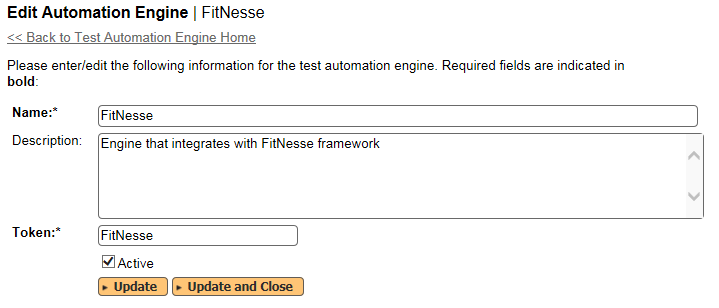
-
Name: This is the short display name of the automation engine. It can be anything that is meaningful to your users.
-
Description: This is the long description of the automation engine. It can be anything that is meaningful to your users. (Optional)
-
Active: If checked, the engine is active and able to be used for any project.
-
Token: This needs to be the assigned unique token for the automation engine and is used to tell RemoteLaunch which engine to actually use for a given test case. For FitNesse this should be simply FitNesse.
-
Once you have finished, click the "Insert & Close" button and you will be taken back to the Test Automation list page, with FitNesse listed as an available automation engine.
Advanced Settings¶
You can modify the FitNesse configuration for each of the specific automation hosts, by right-clicking on the RemoteLaunch icon in the system tray and choosing "Configuration". That will bring up the RemoteLaunch configuration page. The FitNesse engine adds its own tab to this page which allows you to configure how FitNesse operates:
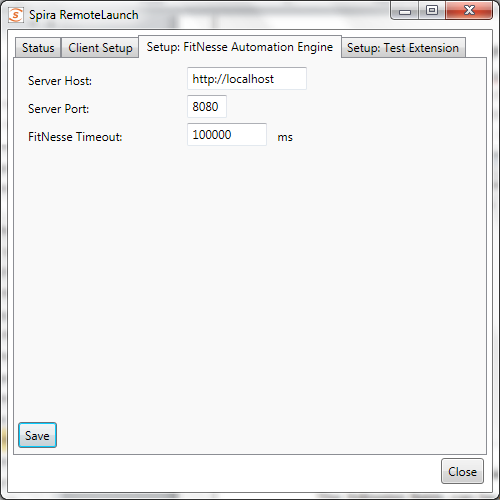
The following fields can be specified on this screen:
Server Host -- This should be the base URL for accessing the installation of FitNesse. Each of the FitNesse test cases will be a URL relative to this base URL.
Server Port -- This should be set to the TCP port that the FitNesse web server uses for displaying the FitNesse wiki web pages.
FitNesse Timeout -- This allows you to extend the timeout for executing FitNesse tests. This is useful if you find that the FitNesse tests take a long time to execute and RemoteLaunch is aborting the execution before they are finished.
Setting up the Automated Test Cases¶
This section describes the process for setting up a test case in SpiraTeam for automation and linking it to an existing FitNesse test case wiki page. Note: The FitNesse automation engine only supports Linked test scripts in SpiraTeam (not Attached).
First you need to display the list of test cases in SpiraTeam (by clicking Testing > Test Cases) and then add a new test case. Once you have added the new test case, click on it and go to the "Automation" section located in the "Overview" tab:
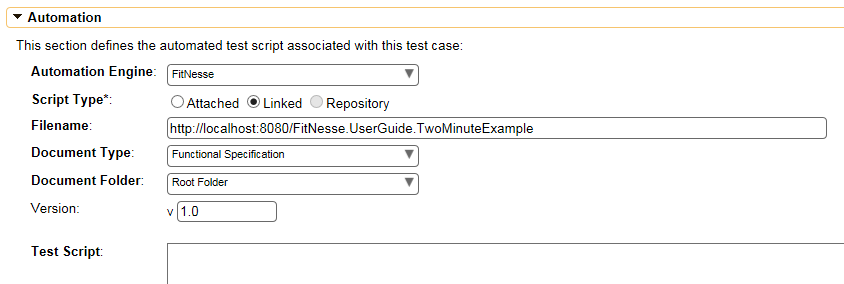
You need to enter the following fields:
-
Automation Engine - Choose the FitNesse Automation Engine that you created in the previous section from the drop-down list.
-
Script Type -- This should be set to Linked for FitNesse tests.
-
Filename -- This needs to be the relative URL of the FitNesse test case. I.e. if the FitNesse URL is http://myserver/FitNesse.UserGuide.TwoMinuteExample and the base URL setup in RemoteLaunch is http://myserver then the "filename" would be just FitNesse.UserGuide.TwoMinuteExample.
-
Document Type -- You can choose which document type the automated test script will be categorized under.
-
Document Folder -- You can choose which document folder the automated test script will be stored in.
-
Version -- The version of the test script (1.0 is used if no value specified)
-
Test Script -- This is not used when you are using the linked test script option
Once you are happy with the values, click [Save] to update the test case. Now you are ready to schedule the automated test case for execution.
Using Parameterized Test Cases¶
The FitNesse automation engine does not currently support the passing of parameter values from SpiraTeam to the FitNesse test.
Executing the FitNesse Test Sets from SpiraTeam¶
There are three ways to execute automated test cases in SpiraTeam:
-
Schedule the test cases to be executed on a specific computer (local or remote) at a date/time in the future
-
Execute the test cases right now on the local computer.
-
Execute the test cases from the command-line or a build script
We shall outline each of these three scenarios in this section. However first we need to setup the appropriate automation hosts and test sets in SpiraTeam:
Configuring the Automation Hosts and Test Sets¶
Go to Testing > Automation Hosts in SpiraTeam to display the list of automation hosts:

Make sure that you have created an Automation Host for each computer that is going to run an automated test case. The name and description can be set to anything meaningful, but the Token field must be set to the same token that is specified in the RemoteLaunch application on that specific machine.
Once you have at least one Automation Host configured, go to Testing > Test Sets to create the test sets that will contain the automated test case:

Note: Unlike manual test cases, automated test cases must be executed within a test set -- they cannot be executed directly from the test case.
Create a new Test Set to hold the FitNesse automated test cases and click on its hyperlink to display the test set details page:
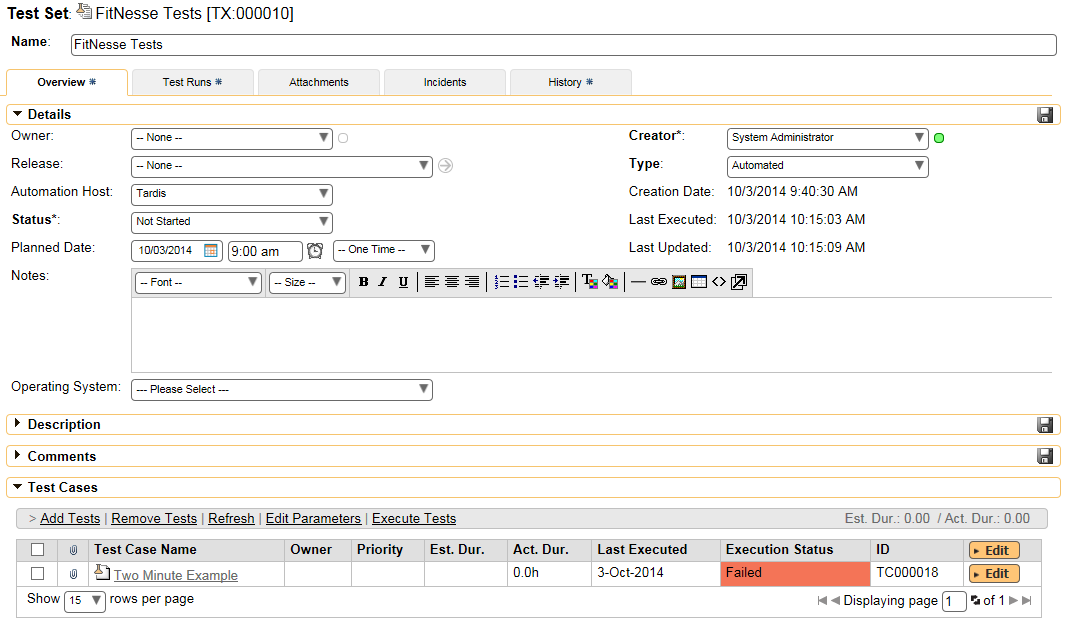
You need to add at least one automated test case to the test set and then configure the following fields:
-
Automation Host -- This needs to be set to the name of the automation host that will be running the automated test set.
-
Planned Date -- The date and time that you want the scenario to begin. (Note that multiple test sets scheduled at the exact same time will be scheduled by Test Set ID order.)
-
Status -- This needs to be set to "Not Started" for RemoteLaunch to pick up the scheduled test set. When you change the Planned Date, the status automatically switches back to "Not Started"
-
Type -- This needs to be set to "Automated" for automated testing
Executing the Test Sets¶
Once you have set the various test set fields (as described above), the Remote Launch instances will periodically poll SpiraTeam for new test sets. Once they retrieve the new test set, they will add it to their list of test sets to be executed. Once execution begins they will change the status of the test set to "In Progress", and once test execution is done, the status of the test set will change to either "Completed" -- the automation engine could be launched and the test has completed -- or "Blocked" -- RemoteLaunch was not able to start the automation engine.
If you want to immediately execute the test case on your local computer, instead of setting the "Automation Host", "Status" and "Planned Date" fields, you can instead click the [Execute] icon on the test set itself. This will cause RemoteLaunch on the local computer to immediately start executing the current test set.
In either case, once all the test cases in the test set have been completed, the status of the test set will switch to "Completed" and the individual test cases in the set will display a status based on the results of the FitNesse test:
Passed -- The FitNesse automated test ran successfully and all the test conditions in the test script passed
Failed -- The FitNesse automated test ran successfully, but at least one test condition in the test script failed.
Blocked -- The FitNesse automated test did not run successfully
If you receive the "Blocked" status for either the test set or the test cases you should open up the Windows Application Event Log on the computer running RemoteLaunch and look in the event log for error messages.
Note: While the tests are executing you may see command windows appear as the FitNesse server executes the appropriate tests.
Once the tests have completed, you can log back into SpiraTeam and see the execution status of your test cases. If you click on a Test Run that was generated by FitNesse, you will see the following information:

This screen indicates the status of the test run that was reported back from FitNesse together with any messages or other information. The execution status will be set to PASSED if all the FitNesse rows report back OK and all the tests passed. If any of the rows failed or the tests don't pass, the overall execution status will be listed as FAILED.
You can see a step-by-step record of what happened by scrolling down to the "Test Steps" section:
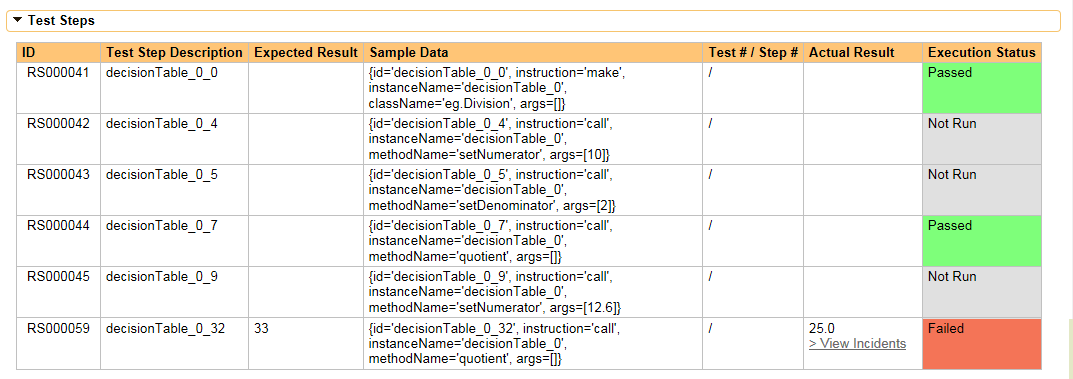
In addition, you can scroll down to the "Console Output" section to get the FitNesse specific information:
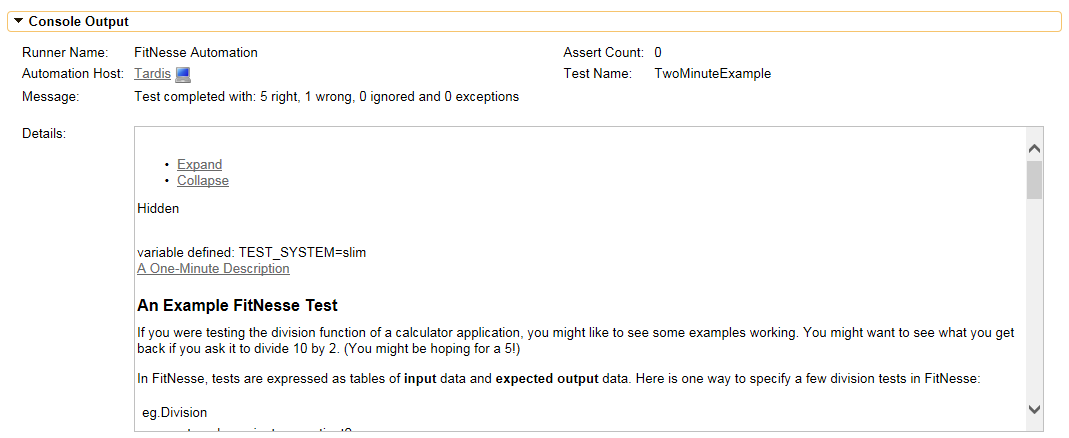
The Message field will contain a summary of the number of tests executed and the number of wrong results and exceptions. The large details box contains the full command execution log as reported back from FitNesse:
Congratulations... You are now able to run FitNesse automated acceptance tests and have the results be recorded within SpiraTest / SpiraTeam.